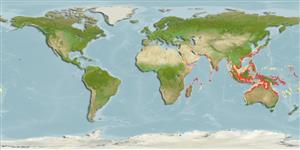Teleostei (teleosts) >
Ovalentaria/misc (Various families in series Ovalentaria) >
Ambassidae (Asiatic glassfishes)
Etymology: Ambassis: Derived from Greek, anabasis = climbing up (Ref. 45335).
Eponymy: Jean-Jacques Dussumier (1792–1883) was a French merchant, collector, traveller and ship owner. [...] (Ref. 128868), visit book page.
More on author: Cuvier.
Environment: milieu / climate zone / depth range / distribution range
Ecology
Marine; freshwater; brackish; demersal. Tropical
Indo-West Pacific from Algoa Bay in South Africa, north to the Red Sea, Seychelles, and eastward around India and Australasia to the Philippines and China (Ref. 50956).
Size / Weight / Age
Maturity: Lm ? range ? - ? cm
Max length : 10.0 cm SL male/unsexed; (Ref. 52193)
Dorsal spines (total): 7 - 8; Dorsal soft rays (total): 8 - 10; Anal spines: 3; Anal soft rays: 8 - 11. Diagnosis: Ambassis dussumieri has the following combination of characters: supraorbital spines 1-5, usually 3-4; rostral spine present; rear margin of preopercle smooth (at least dorsally); interopercle edge smooth; two rows of cheek scales; predorsal scales 13-16; lateral line discontunuous; lower gill rakers 22-25; pectoral-fin rays 14-16 (Ref. 50956).
Occurs in estuarian and coastal areas but also in freshwaters (Ref. 57749). Generally occurs in the seas and estuaries, but also found in rivers within tidal influence (Ref. 4833). Also Ref. 43640.
Life cycle and mating behavior
Maturity | Reproduction | Spawning | Eggs | Fecundity | Larvae
Maugé, L.A., 1986. Ambassidae. p. 297-298. In J. Daget, J.-P. Gosse and D.F.E. Thys van den Audenaerde (eds.) Check-list of the freshwater fishes of Africa (CLOFFA). ISNB, Brussels; MRAC, Tervuren; and ORSTOM, Paris. Vol. 2. (Ref. 4180)
IUCN Red List Status (Ref. 130435: Version 2024-1)
Threat to humans
Harmless
Human uses
Fisheries: of no interest
Tools
Special reports
Download XML
Internet sources
Estimates based on models
Preferred temperature (Ref.
123201): 24.6 - 29, mean 28 °C (based on 1014 cells).
Phylogenetic diversity index (Ref.
82804): PD
50 = 0.5000 [Uniqueness, from 0.5 = low to 2.0 = high].
Bayesian length-weight: a=0.01202 (0.00496 - 0.02912), b=3.02 (2.83 - 3.21), in cm total length, based on LWR estimates for this Genus-body shape (Ref.
93245).
Trophic level (Ref.
69278): 3.4 ±0.4 se; based on size and trophs of closest relatives
Resilience (Ref.
120179): High, minimum population doubling time less than 15 months (Preliminary K or Fecundity.).
Fishing Vulnerability (Ref.
59153): Low vulnerability (10 of 100).
